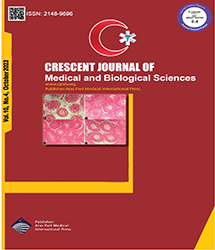
| Original Article | |
| Foveal and Retinal Nerve Fiber Layer Thickness in Children With a History of Retinopathy of Prematurity Treated With Bevacizumab: A Cross-sectional Study | |
| Amir Eftekhari Milani1, Bahareh Javani1,2, Mohamadhosein Ahoor1, Mehdi Abdi Shahshahani1, Fereshteh Farhadi1,2,3 | |
| 1Nikookari Eye Center, Tabriz University of Medical Sciences, Tabriz, Iran 2Student Research Committee, Tabriz University of Medical Sciences, Tabriz, Iran 3Research Center for Evidence-based Medicine, Iranian EBM Centre: A JBI Centre of Excellence, Faculty of Medicine, Tabriz University of Medical Sciences, Tabriz, Iran |
|
|
CJMB 2023; 10: 169-175 DOI: 10.34172/cjmb.2023.27 Viewed : 2440 times Downloaded : 2101 times. Keywords : Retinopathy of prematurity, Bevacizumab, Foveal thickness, RNFL thickness |
|
| Full Text(PDF) | Related Articles | |
| Abstract | |
Objectives: This study aimed to investigate the effects of bevacizumab (an anti-VEGF antibody) on the structure of retina such as the thickness of the nerve fiber layer and macula with optical coherence tomography (OCT) in retinopathy of prematurity (ROP) patients. Materials and Methods: This cross-sectional study was conducted in 2021-2022 in Tabriz, Iran to investigate preterm children aged 4-6 years. To this end, a total of 300 eyes of 150 children were assigned to three groups and then were examined by performing Fundus examination of retina, eye refraction test, and OCT imaging. The first group included 100 eyes with a history of ROP and treated with bevacizumab, the second group consisted of 100 eyes with a history of ROP but improved spontaneously, and the third group comprised 100 eyes of preterm children without a history of ROP. Results: Foveal thickness was 235.46 ± 11 μm in the group receiving bevacizumab, 267.70 ± 12 μm in the group with spontaneous improvement of ROP, and 269.48 ± 10 μm in the group with no ROP. Therefore, the mean thickness of the fovea in the group receiving bevacizumab was significantly lower than that in the other two groups. In the group receiving bevacizumab, moreover, the thickness of the nerve layer of the retina was less than that in the other two groups (P < 0.005). Conclusions: In sum, a greater understanding of the development of premature fovea was achieved, which may have facilitated identifying the possible clinical and long-term effects of these abnormal changes on adulthood visual acuity. It was recommended that further studies should be carried out to compare laser-treated eyes in order for expanding the scientific understanding of the development of premature fovea and other aspects of ROP, which may have decreased the preventable blindness rate. |
Cite By, Google Scholar
Google Scholar
PubMed
Online Submission System
 CJMB ENDNOTE ® Style
CJMB ENDNOTE ® Style
 Tutorials
Tutorials
 Publication Charge
Medical and Biological Research Center
About Journal
Publication Charge
Medical and Biological Research Center
About Journal
Aras Part Medical International Press Editor-in-Chief
Arash Khaki
Deputy Editor
Zafer Akan



















